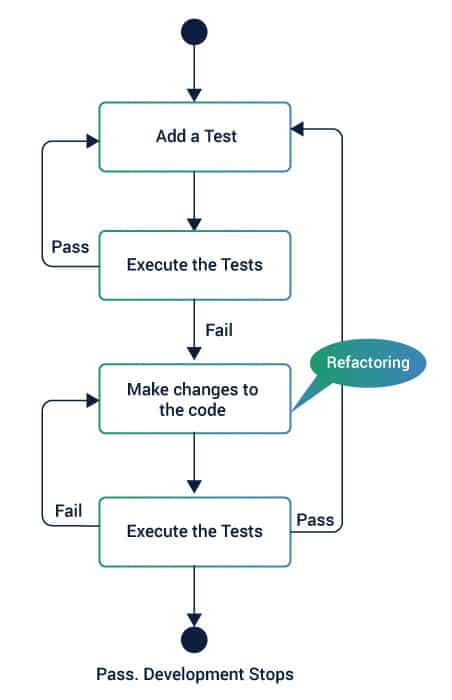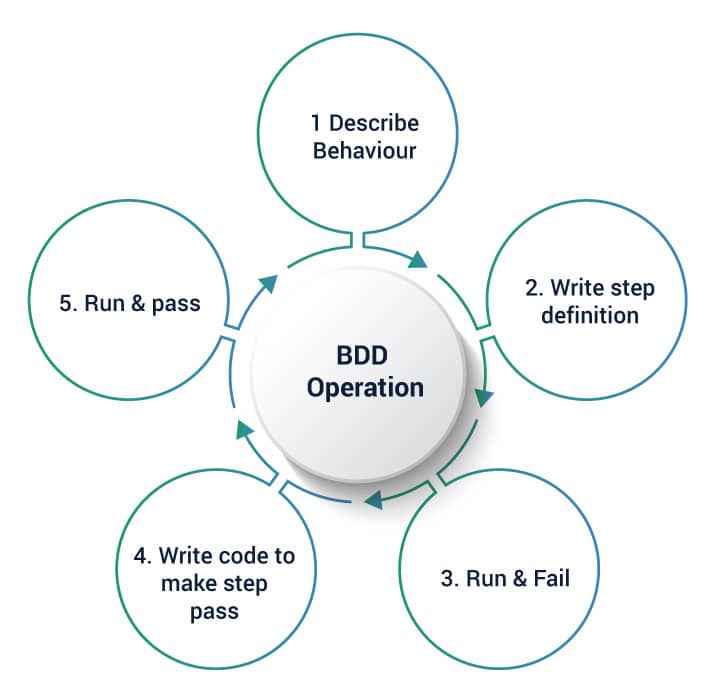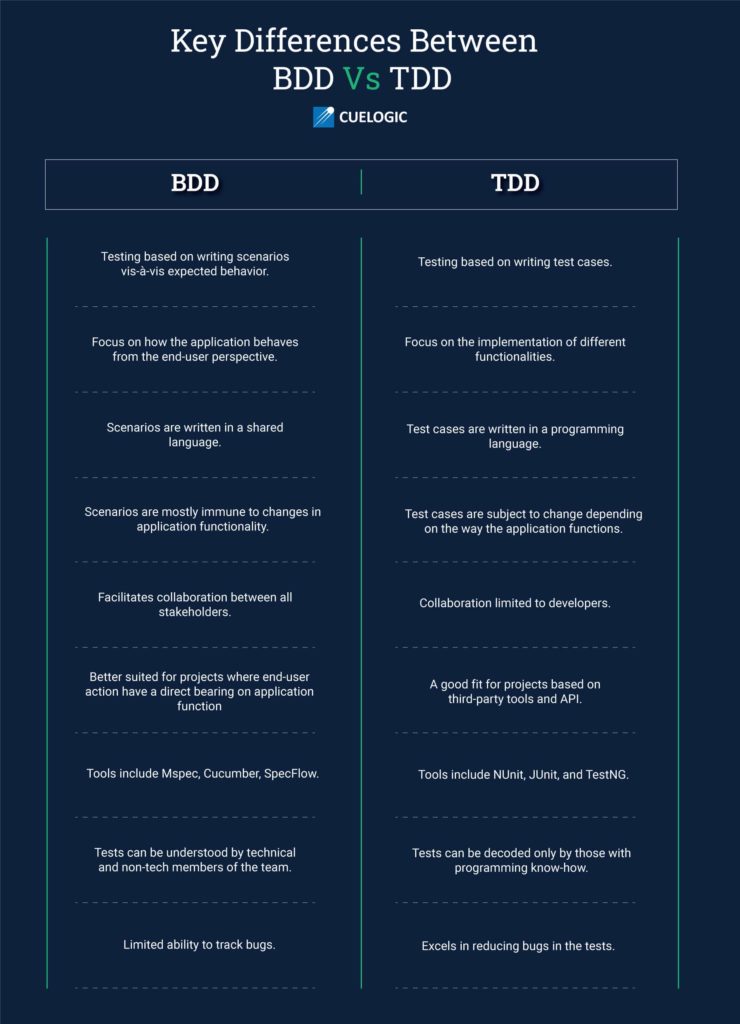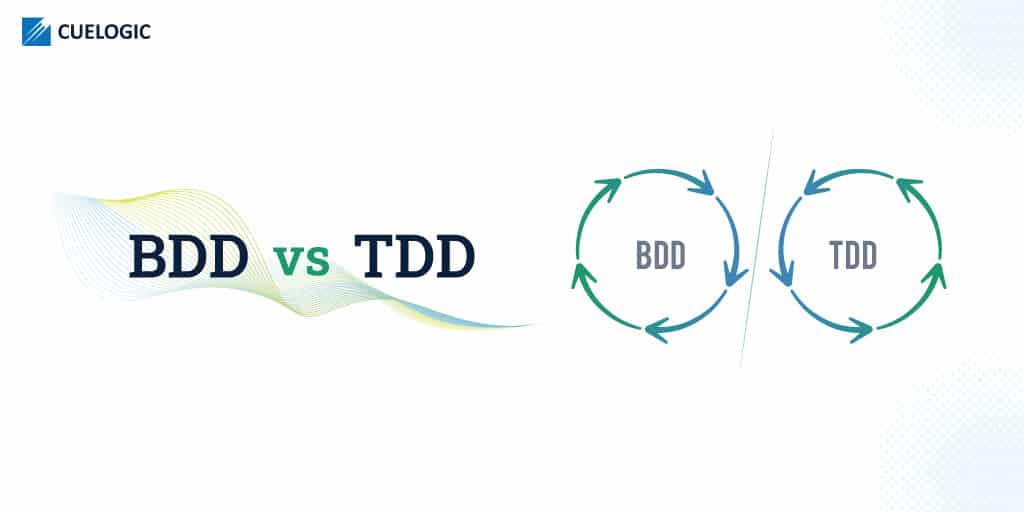The cascade to agile approach shift in software development over the past decade has ushered in an era of continuous testing and change. This new approach in quality engineering has single-handedly made the development process more dynamic by equipping developers with the ability to introduce new changes and prevent bugs or breakdowns from impeding the scalability of applications.
Anyone operative in the agile development environment is likely to be familiar with the terms behavior-driven development (BDD) and test-driven development (TDD). Since the two terms are similar sounding, it’s easy to confuse one for the other or treat them to be synonymous. However, that’s not the case.
Even though both BDD and TDD are test-first approaches, the processes are markedly different. In TDD, a written test case is used to check the efficacy of application functionality. BDD, on the other hand, tests the system’s behavior from the perspective of the end-user.
So, how do these differences translate in terms of test results and application robustness? What are the drawbacks and benefits of each approach? And can the two be used in conjunction? Let’s take a closer look at BDD vs TDD:
What is TDD?

TDD or Test-driven Development is a testing methodology that fits into the programming practice from a developer’s point of view. In this approach, a quality assurance engineer uses the TDD testing approach after designing and writing test cases for each minuscule functionality of an application to address a simple, singular question – is the code valid?
The intent here is straightforward – to test whether a freshly written code holds water and to modify or rewrite it only in case it fails the TDD test. As a result, this testing approach helps reduce test script duplication to a large extent, making it a hugely popular technique for optimizing the ecosystem of agile development.
Since it is a test-first approach, automated test scripts are typically written before the code. The TDD process entails the following steps:
- A developer writes an automated test script depending on the pre-specified requirements.
- The test is executed. Since these tests are developed before the code is written, these tend to fail in certain cases. In other cases, it can give false results, which is the biggest known drawback of the Test-Driven Development technique.
- The code is re-factored for passing the pre-designed test successfully.
Test-Driven Development Benefits:
Without a TDD has its share of drawbacks and shortcomings but its pros far outweigh the cons. Some of the key benefits of using the TDD technique include:
- It is extremely efficient in explore errors, bugs, and breakdowns in a short window of time.
- Since the test returns pointed insights, it reduces the effort and time needed to rework any component of an application.
- The developers have access to faster feedback.
- Promotes an ecosystem for more competent and cleaner designs.
- Augments programming productivity.
- Aids development of easy to maintain, flexible, and extensive code.
- The TDD approach can be leveraged to make changes to the large architecture of any application with precision and confidence.
- Encourages collaboration and knowledge sharing in the code development process, equipping the entire team with adequate access and know-how to proceed even in the absence of key team members.
What is BDD?

Business-Driven Development or BDD is an extension of a Test-Driven Development (TDD) technique. It builds upon the core test-front ethos of the TDD methodology. In this case, the tests are focused on the behavior of the systems. Different features or components of an application are developed based on these behavioral predictions. The most common approach used for BDD testing is dubbed as Given-When-Then.
This means – given that the user enters valid login credentials, you predict the next step, which is when a user completes the login process by clicking on the button, and the outcome, which is then the successful validation message is displayed.
As is evident from the above-mentioned process, the BDD testing is carried out in a shared language – or simply put, in easy-to-understand English – making it easy for everyone on the team to comprehend the feature behavior accurately.
BDD also plays a crucial role in cutting back the risk of bugs and errors in the task late stages of the development cycle (SDLC). Given how expensive debugging at this point can be, one of the key advantages of BDD is its ability to week out ambiguities vis-à-vis requirements, thus ensuring that development efforts across the board remain aligned and in sync.
This is achieved by using simple English to define requirements and approaches and illustrating real-world scenarios using different means to establish a clear understanding of the end goal. With these functionalities, the BDD technique accords the technical and non-tech teams a common platform for collaboration and exchange of knowledge and ideas.
Behavioral-Driven Development Benefits:
As is clear, BDD is a more evolved approach as compared to TDD in many ways. Some of the key benefits it brings to the development process include:
- Facilitating a wider outreach of goals by relying on non-technical language in defining goals and requirements.
- A more cost-effective methodology for testing.
- Cuts back on the cost and effort of verifying and correcting post-deployment shortcomings.
- Focus on application behavior from the perspective of the developer as well as the end-users.
Key Differences between BDD and TDD

BDD and TDD can seem to have a wide spectrum of similarities and that’s not just because of their similar-sounding nomenclature but also their purpose. But techniques are designed to test software applications. In both methodologies, tests are written before the code. Both can be used as part of the automated testing framework with the objection of preventing breakdowns, errors, and bugs.
Even so, both these development testing techniques are markedly different from one another in the following ways:
Scope of Testing
BDD is meant to test how an application behaves from the perspective of the end-user, whereas TDD tests small components of an application for functionality in isolation. TDD is concerned with the outcome of a specific method and BDD with the outcome of more complex scenarios.
To put it simply, TDD says: ‘I need to carry out a pre-designed test in a particular way without being concerned about the outcome.’ On the other hand, BDD says: ‘The process is immaterial as long as the outcome is correct in the pre-defined condition.’
Method of Testing
TDD is a more traditional approach to software testing, done by developers and QA engineers without any involvement of stakeholders such as product managers. In sharp contrast, BDD is more inclusive and facilitates collaborations between product managers, test engineers, developers, among other stakeholders, to achieve the desired functionality.
Feedback and Communications
In terms of the process of feedback and communication too, BDD has a definitive edge over TDD. Since the behavior descriptions, as well as scenarios, are described in plain English, it becomes easier not just for non-technical team members but also for the clients to understand the test process and share their observations and comments with the tech teams.
This paves the way for more open two-way communication lines that can streamline the process of sending, receiving, and incorporating feedback, ultimately uplifting the quality of software design and testing. In TDD, the ability to understand the test is limited to skilled programmers. While this approach limits communication outreach, it more than makes up for it with the quality of code.
Writing Tests
As mentioned before, in both BDD and TDD, writing the test precedes the development process. However, the difference lies in what these tests seek to accomplish. In TDD, the test is written with a view to satisfying the developer and the code written by them. In BDD, the test seeks to satisfy the developer as well as the end-user.
TDD and BDD Best Practices
Both TDD and BDD have their unique uses and benefits. To leverage these optimally, it’s vital to adopt the right practices and approach for deploying each of these testing methodologies. Here is a rundown on the TDD and BDD best practices:
Best practices for TDD:
- Write an automated test case based on requirements.
- Run the automated test case on the developed code.
- If code developed for the test case fails to yield desired results, rework it to obtain the desired outcome.
- Re-run the test cases to ascertain whether they are implemented correctly.
- Refactor your code, depending on the test case results, to make it reusable and enhance its readability.
- Repeat this cycle until all test cases are implemented for a particular software.
Best practices for BDD:
- Write the scenarios for application behavior in simple English so that it can be understood by business analysts, product owners, QAs, and developers alike.
- Convert the behavior scenarios into programming tests using automated scripts.
- Implement the functional coder that underlies the behavior scenario.
- Run the behavior to check for whether it’s successful. If it is, move on to the next scenario. If it isn’t, then fix the functional code errors until the desired behavior is achieved.
- Reorganize or refactor the code of improved readability and reusability.
- Repeat these steps for implementing different behavior scenarios in your application.
Can BDD and TDD Work Together?
BDD and TDD have their differences and similarities, but they’re not mutually exclusive. While it’s not unusual for Agile teams to use one without the other, making the two work together can ensure a higher degree of efficiency in testing application use cases, thus bringing in greater confidence in their performance.
For instance, the BDD approach can be used by a development team, alongside TDD, to put in place a higher level of testing that not only takes care of technical nuances from a developer’s point of view but also assesses the application’s behavior. To implement the specifics, developers can create separate testing units to maintain the robustness of different components. This can be especially beneficial considering that the same component can be used in different places across an application.
A fitting example of how BDD and TDD can be combined and leverage in a single framework is Rspec, a testing tool written for testing the Ruby code. Ruby applications are tested using a mix of BDD and TDD principles.
To begin with, the testing process is based on specifying text descriptions in simple language. Developers add TDD elements for testing certain specific components. Whether to choose BDD over TDD or vice-versa or use a combination of the two methods is a choice governed by the individual needs of an application or organization.
That said, experimenting with BDD when you’re already doing TDD testing – or vice-versa – can add value to the software development process. What makes using the two together easier is that you don’t need to change or rework the existing practice. All it takes is building up the testing framework to accommodate the other.
Conclusion
Understanding how the BDD and TDD techniques work can help software developers, as well as other stakeholders, improve on the agile development process by zeroing in on the best test strategy for their needs. Depending on the nature of the project and the desired result, you can choose between or use a mix of the two techniques to enhance test coverage efficiency.
